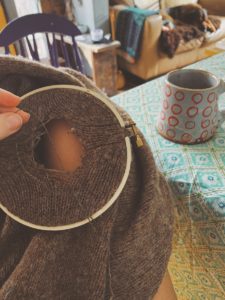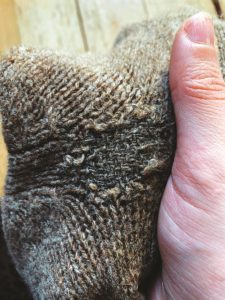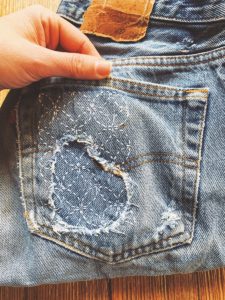We all have at least one piece of clothing that we can’t bear to let go of, even though its state of repair limits its public appearances. Mine is a bulky dark-gray wool sweater that, though accidentally shrunken and with holes in both elbows, is my daily go-to in the winter. It is dense, too short, and utterly beloved. But as the years go on, the holes grow, and with them, the fear that this favorite layer will one day provide more ventilation than warmth.

Kiah Coble of Provincetown has no fear of fraying. Instead, she sees well-worn and well-loved pieces as opportunities for artistic expression.
“The first thing I ever darned was a pair of socks,” she says, “and I hated it.” But she was drawn to darning sweaters. The attraction was initially a practical one. “It mostly started because sweaters are expensive and they take a really long time to make.”
For wool pieces, Coble buys a wool blend thread. It is very “particular,” she notes. If you tug on it too hard, it rips. She centers the hole she’s repairing on an embroidery hoop to keep the fabric taut and easier to handle.
To begin, she looks for a few threads to grab onto along the “jaggedy” edges of the hole. “The garment will tell you where to start,” she says. She picks up the threads with a darning needle and, following the weave of the sweater, begins to build a lattice. “You want to make sure you’re grabbing all the loose threads as you make your way across,” she explains. “Then you just start working your way in and out and over and under until it ends up looking like an open weave.”

It was only about a year ago that Coble started doctoring her clothing. She credits YouTube for learning technique, and, although she describes her work as highly perfect, that suits her style. “I really like things that are kind of wonky, fixed up, or home made,” she says, “and I wanted to be able to do that myself.”
Coble is a printmaker and the curator of adult education at the Provincetown Art Association and Museum. Making things with her hands — things that most of us have forgotten how to do — comes naturally for her.
“I really like fabrics, textiles, and yarn,” she says. “But the tactile experience of working with fabric is so different from working with paint.” There is a parallel progression, however. “When you’re a kid, you fingerpaint, then you use a brush,” Coble explains. “In sewing there are tools, but you really work with the fabric itself.”

There is something powerfully satisfying about bringing things back to life. “I’m about to embark on mending a dress that was my mom’s that she got at Silk and Feathers in the early ’90s,” Coble says. “Both of the armpits have ripped out, but it’s my favorite dress, so I really want to figure out how to fix it and make it wearable again.”
Mending has a long and vibrant history, Coble says. Learning to darn, she couldn’t help studying examples that span centuries and cultures — from intricate silk Dutch darning patterns to the high-contrast Japanese practice of sashiko.
Western “slow fashion” has adopted sashiko as a way of mending that makes the garment stronger and last longer, Coble says. But as she shows some of her own experiments in the method, she adds, “I am by no means an expert, and I don’t want to culturally appropriate a Japanese mending style.”

She flips a pair of jeans inside out and sews fabric into the hole. Using a machine makes for a mending job that will last, she says, though working entirely by hand works fine if you’re prioritizing aesthetics. Over the patches, Coble’s intricate sashiko patterns play across gently worn denim, drawing your eye in, then revealing more detail. Little pops of red sprout up on the toes of a pair of slippers. There is an undeniable joy stitched into every tear and hole.
That’s led to Coble offering her mending as a practical gift. “Mending a sweater for somebody takes time and you can put a lot of love into it that way,” she says. Besides, “no one needs more stuff.” What you do need is “for the stuff you have to continue on.”



